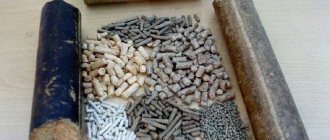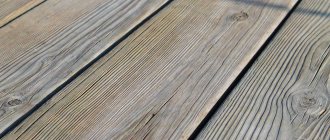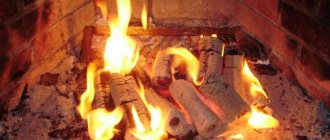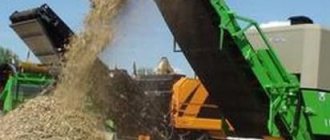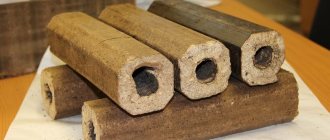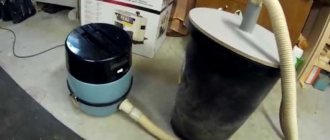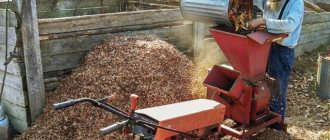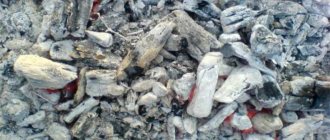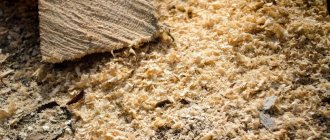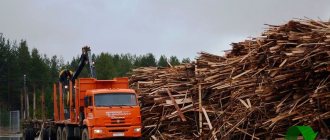Sawdust flavoring
Due to its excellent absorbent properties, sawdust can be used as a natural flavoring agent. There are two options on how to do this:
- if you have juniper or pine sawdust, pour it into a fabric bag and tie it tightly with a ribbon;
- Soak sawdust from any tree with essential oil and place it in a jar or bag, tie it or cover it with a lid.
Place sachets with fragrant sawdust in the closet where clothes and linen are stored, or place them in the room.
Formation
During woodworking operations such as sawing, routing and sanding, two waste products are generated on the work surface - dust and shavings. These operations destroy both lignified wood cells and entire cells and groups of cells. The destruction of wood cells leads to the formation of dust, and the destruction of entire groups of wood cells leads to the formation of chips. The more cell destruction occurs, the smaller the dust particles are formed. For example, sawing and milling are mixed processes of cell crushing and chip formation, while grinding is almost exclusively cell crushing.[1]
Growing mushrooms on sawdust
Did you know that oyster mushrooms can be grown in the most common sawdust? The substrate is prepared from large hardwood sawdust and straw (you can use feed or sunflower seed husks), mixed in a 3:1 ratio. The components must be processed: soak the mass in hot water for 3-7 hours, maintaining a temperature of 60°C.
Then, when the substrate has cooled, it needs to be squeezed out and placed in layers in a thick transparent plastic bag, sprinkling each layer with crushed mycelium. Several small holes are made in the bag. With proper care, mushrooms will grow in 40-45 days.
Sawdust compost
Sawdust is used as fertilizer for many plants. There is one “but” - fresh sawdust cannot be used, as it will “pull” the nitrogen necessary for crops to grow from the soil. The way out of the situation is to prepare compost from sawdust.
If the compost is “filled” with sawdust, this will speed up its maturation. Sawdust improves the structure of the compost: they make it looser and increase air permeability. Another “plus” is that such compost will warm up faster in the spring. At the beginning of summer, start a compost heap, laying out sawdust (10 kg) in layers. Each layer must be shed with water in which fertilizers are dissolved:
- 130 g urea;
- 10 g superphosphate;
- 70 g potassium chloride.
Also, each layer needs to be sprinkled with lime (150 g of lime will be needed for a pile 1.5 m high). When the compost is ready, it is added to the soil at the rate of 2-3 buckets per 1 sq.m. The optimal time to add compost is late summer.
- How to make the right compost for feeding plants
Fertilizing the soil is an important part of plant growing activities. And compost is considered one of the leaders in the “world of fertilizing”.
Sawdust mulch
This natural material is used to mulch beds, soil under berry bushes, tree trunks, etc. For mulching, you can use semi-rotted or rotted sawdust.
Since fresh sawdust is harmful to plants (they absorb nitrogen from the soil), they need to be prepared before use: pour 3 buckets of sawdust, 200 g of urea and 10 liters of water onto a spread film in layers. The top of the sawdust is covered with a film and pressed down with something heavy. After 2 weeks, the sawdust can be used.
Lay out rotted sawdust in a layer of 5-10 cm. Mulching with sawdust helps control weeds and helps retain moisture in the soil.
- How to mulch in the fall - options for every taste
We offer 10 options for autumn mulch, thanks to which your heat-loving plants will cope well with the winter cold.
Mulching
They are in high demand in agricultural and home plant growing as a covering and mulching agent. Suitable for laying soil around bushes, trees, seedlings because:
- have a positive effect on the development of plantings;
- protect the earth's surface from erosion;
- protect trunks from differences in daily temperature;
- prevent moisture evaporation;
- inhibit the development of weeds.
Mulching example
Sawdust for smoking
If you are the happy owner of your own smokehouse, then you probably know that sawdust is an excellent material for kindling.
Sawdust from alder, oak and fruit crops: apple, cherry, apricot, sea buckthorn are best suited for a smokehouse. But the most unsuitable trees, the sawdust of which should not be used for these purposes, are aspen and conifers.
Sawdust for smoking must be of high quality, so before use, make sure that there is no mold or traces of chemical treatment on it. Soak the sawdust in warm water for 4-5 hours, then dry (optimal humidity 50-70%).
- Smokehouse in the country - choose the appropriate option
Can you imagine a day outside the city without smoked fish or a piece of meat? Especially if these “delicacies” are obtained using a personal smokehouse?
Health Hazards
Airborne sawdust and sawdust accumulations present a number of health and safety hazards.[9] Wood dust becomes a potential health problem when, for example, wood particles from processes such as sanding become airborne and inhaled. Wood dust is a known human carcinogen.[10][11] Some types of wood and their dust contain toxins that can cause serious allergic reactions.[12]
Inhalation of wood dust can cause allergic, mucosal and non-allergic respiratory symptoms, as well as cancer.[13] In the United States, lists of carcinogens are published by the American Conference of Governmental Industrial Hygienists (ACGIH), the Occupational Safety and Health Administration (OSHA), and the National Institute for Occupational Safety and Health (NIOSH). All of these organizations recognize wood dust as a carcinogen to the nasal cavities and paranasal sinuses.[14]
Shavings made by a Japanese airplane
People may be exposed to wood dust in the workplace through inhalation, skin contact, or eye contact. The Occupational Safety and Health Administration (OSHA) has set the legal limit (permissible exposure limit) for exposure to wood dust in the workplace as 15 mg/m3 total exposure and 5 mg/m3 respiratory exposure over an 8-hour workday. The National Institute for Occupational Safety and Health (NIOSH) has set a recommended exposure limit (REL) of 1 mg/m3 over an 8-hour workday.[15]
Sawdust for garden paths
A garden path made from sawdust is a simple, cute and convenient way to decorate your garden. Dig a shallow trench of any shape (about the size of a shovel), fill it with sawdust and compact it. The advantages of such a track:
- it can be made as winding as desired;
- water will not stagnate in it;
- Weeds will not soon break through the sawdust.
Keep in mind that over time, the sawdust in the path will sag, so you will have to add it every year.
- 16 ideas on what you can use to make a beautiful and practical garden path
A large selection of interesting and simple options for garden paths.
References
- IARC 1995. Wood dust
.
In IARC Monograph on the Assessment of Carcinogenic Risks to Humans
. Volume 62: Wood dust and formaldehyde. Lyon, France: World Health Organization International Agency for Research on Cancer, p.70. - Felman, David (2005) “Why were bars used to put sawdust on the floor? Why aren’t there any more?” Why does the elephant jump?
HarperCollins, New York, p.118, ISBN 978-0-06-053914-6 - quoting Christopher Halleron, bartender and beer columnist. - Green, Harvey (2006) Wood: Craft, Culture, History
Penguin Books, New York, p. 403, ISBN 978-1-1012-0185-5 - Nassauer, Sarah (4 May 2011). "Why Wood Pulp Makes Ice Cream Creamier." Wall Street Magazine
. - Packaging plants used to purchase large quantities of sawdust for cutting room floors, but still purchase sawdust for use as fuel and flavoring in the smoking process.
- Savich, I. V. (1985). "Small-scale sausage production: sausage casings." Rome: Food and Agriculture Organization of the United Nations (FAO).
- "Bread Labels on Wood Fibers".. Los Angeles Times
. October 9, 1985 Archived from the original September 16, 2010 - Nyzli, Miklos (2011). "3". Auschwitz: A Doctor's Eyewitness Account
. New York: Arcade Publishing. paragraph 34. - "Exposure to Wood Dust." State Compensation Insurance Fund. Archived from the original on May 4, 2012. Retrieved April 30, 2012.
- "Carcinogen Report, Twelfth Edition, Wood Dust" (PDF). Archived from the original (PDF) on February 17, 2013. Retrieved July 12, 2014.
- “FINAL Report on Wood Dust Carcinogens Background Document” (PDF). Retrieved July 12, 2014.
- Meyer, Eric. "Wood Allergy and Toxicity." Wood database.
- US Department of Labor: Occupational Safety and Health Administration. Wood dust.
- Baran, S. & Teul, I. 2007. Wood dust: an occupational hazard that increases the risk of respiratory diseases. Journal of Physiology and Pharmacology 58, supplement. 5. pp. 43–50.
- "CDC - NIOSH Pocket Guide to Chemical Hazards - Wood Dust." www.cdc.gov
. Retrieved 2015-11-28. - Edison Diamond Blade Information from Tim Grasik
- Yuanhui Zhang, 2004. Indoor Air Quality Engineering
. Boca Raton, FL: CRC Press, p.14. - Yuanhui Zhang, 2004. Indoor Air Quality Engineering
. Boca Raton, FL: CRC Press, p.18 - Baran, S. & Teul, I. 2007. Wood dust: an occupational hazard that increases the risk of respiratory diseases. Journal of Physiology and Pharmacology 58, supplement. 5. pp. 43–50.
- Baran, S. & Teul, I. 2007. Wood dust: an occupational hazard that increases the risk of respiratory diseases. Journal of Physiology and Pharmacology 58, supplement. 5. pp. 43–50.
- IARC 1995. IARC Monographs on Assessing Carcinogenic Risks to Humans. Volume 62: Wood dust and formaldehyde. Lyon, France: World Health Organization International Agency for Research on Cancer, p. 66.
- Kaupinnen, T., et.al. 2006. Occupational exposure to respirable wood dust in European Union member states. Ann Occup Hig (2006) 50(6):549-561.
- Final report on carcinogens. Wood Dust Background Document. NTP Board of Scientific Advisors Meeting, December 13–14, 2000. Research Triangle Park, NC: U.S. Department of Health and Human Services Public Health Service National Toxicology Program/Durham, NC: Technology Planning and Management Corporation. Archived 2012-04-17 in the Wayback Machine
- Canadian Geographic Online Archived 2006-04-28 on the Wayback Machine
- Mutchler, J.E., 1973. Chapter 41: Local Exhaust Systems
.
In: Industrial Environment: Its Assessment and Control
. Washington: US Department of Health and Human Services, National Institute for Occupational Safety and Health (NOISH). www.cdc.gov/niosh/pdfs/74-177-w.pdf - Burgess, W. A., et. al., 2004. Ventilation for control of the working environment,
2nd ed. Hoboken, NJ: John Wiley & Sons, p.192. - WHO, 1999. Prevention and control of hazards in the work environment: airborne dust. WHO/SDE/OEH/99.14. Geneva: World Health Organization, Department of Human Environment, Occupational Health and Environment. p.98.
- WHO 2005 Air Quality Guidelines for Europe
2nd ed. WHO regional publications. European Series No. 91. Copenhagen: WHO Regional Office for Europe.
Sawdust for warm beds
Sawdust is useful for constructing organic trenches - the so-called warm beds. In such beds, plants are very comfortable, they receive more nutrients. A layer of scalded sawdust is laid out at the bottom of the trench (depth 40-50 cm), covered with a cloth and watered with a pink solution of potassium permanganate.
The next layer is plant debris (for example, foliage, plant tops), which are sprinkled with ash (1-2 cups per 1 sq.m.). Then a mixture is poured into the trench, which includes humus or peat (5-6 buckets), sand (1 bucket), 1 tbsp. urea, 2 cups of ash, 1.5 tsp. boric acid, 1 tbsp. superphosphate, 1 tsp. potassium sulfate, 1 tsp. zinc sulfate.
- Do-it-yourself warm beds - step-by-step instructions with video
Detailed and visual recommendations for creating warm beds in your garden.
Wood dust control
Dust removal systems are used to reduce the concentration of airborne dust during wood processing. They can be divided into two types. The first are local exhaust ventilation systems, the second are indoor ventilation systems. The use of personal respirators, a form of personal protective equipment, can also isolate workers from dust.
Local exhaust ventilation (LEV) systems
They work with air drawn with suction force through piping systems from the point of dust generation to the waste disposal unit. LEV systems consist of four elements: dust enclosures where dust is generated, ventilation ducts, an air cleaning device (waste separator or dust collector), and an air moving device (fan, also known as an impeller).[25] Air containing dust and wood chips is sucked in by the impeller. The impeller is usually built into or adjacent to the waste disposal unit or dust collector.
There are operating guidelines for LEV systems for woodworking that relate to workplace air quality regulations that exist in many countries. The frequently cited LEV guidelines are set by the ACIAH.
Low Volume/High Velocity (LVHV) Systems
Low volume/high speed gripping systems are a specialized type of LEV that use an exhaust housing designed as an integral part of the tool or located very close to the operating point of the cutting tool. The casing is designed to provide high capture speeds, often in excess of 50 m/s (10,000 ft/min) at the point of contaminant exit. This high velocity is accompanied by air currents, often less than 0.02 m3/s (50 cfm), which arise due to the small face area of the enclosure used.[26] These systems have become popular among portable power tools, although adoption of the technology has not been widespread. Festool is one of the manufacturers of portable power tools that integrate LVHV ventilation into the design of the tool.
Room ventilation systems
If designed appropriately, general ventilation can also be used to control airborne dust. General ventilation often helps reduce contamination of skin and clothing, as well as the deposition of dust on surfaces.[27]
Sawdust as a substrate
Sawdust will make the soil looser, which means more oxygen will flow to the roots of the plant. For the substrate, you need to take old sawdust or add urea to fresh ones (for 1 bucket - 40 g of fertilizer). This will prevent the sawdust from taking nitrogen from the plants. To prepare the seedling substrate, mix the following ingredients:
Mixture 1: sawdust, lowland peat, river sand (in a ratio of 1:2:1).
Mixture 2: sawdust, garden soil, lowland peat (1:1:2).
To the finished mixture (per 10 liters of substrate) add 40 g of double superphosphate, 1/2 cup of ash, 15 g of ammonium nitrate and 40 g of potassium sulfate.
Physicochemical characteristics
This is a lightweight material with a bulk density of about 220-580 kg per cubic meter, depending on the humidity level (standard - from 8% to 15% and above). Reaches a size of no more than 50 mm with a dry windage coefficient of 0.13-0.8 units.
Contains about 27% lignin (the substance that gives plants a woody state) and 70% cellulose, hemicellulose (actually carbohydrates). The ratio of chemical components is distributed as follows:
- nitrogen - 0.1%;
- hydrogen - 6%;
- oxygen - 44%;
- carbon - 50%.
The basic properties, differences and characteristics of crushed wood are described in GOST 23246-78, which regulates this type of raw material. The basic terms and definitions of this material are also indicated there.
DIY sawdust concrete
This environmentally friendly, durable and frost-resistant material is used for the construction of houses and country houses. To make it you will need a concrete mixer. The sawdust is dried and sifted through a sieve with 1x1 cm cells, then mixed with cement and sand. Next, you need to add limestone or clay dough to the mixture and mix, pour water in several stages (after each portion, the mixture needs to be mixed).
Amount of ingredients for medium-density sawdust concrete: 20 kg of sawdust, 20 kg of sand, 10 kg of cement, 15 kg of lime (clay).
Crafts from sawdust
Sawdust is an excellent material for children's (and not only) creativity. You can sculpt figures from sawdust by preparing dough for this (2 cups sawdust, 1/2 cup starch, 1/2 cup water, 5 tbsp PVA glue, 1 tsp vegetable oil). You can also decorate a plasticine figurine with large sawdust, making, for example, feathers for a bird: carefully stick the sawdust into the figurine, creating “plumage.” Small sawdust can be painted in different colors and made into a picture by gluing it onto cardboard.
Other safety hazards associated with wood dust
Aquatic bacteria digest the organic material in the leachate, but use up most of the available oxygen. This high “biological oxygen demand” can suffocate fish and other organisms. It has no less detrimental effect on beneficial bacteria, so it is not at all recommended to use sawdust in home aquariums, as was once done by hobbyists trying to save activated carbon.
Explosions and fire
Main articles: Flammability § Combustible dust, and Dust explosion
Sawdust is highly flammable, and the accumulations serve as a ready source of fuel. Sawdust in the air can be ignited by a spark or even heat buildup and cause an explosion.
Environmental consequences
In sawmills, unless they are processed into particleboard, burned in a sawdust burner, or used as heat for other milling operations, they can accumulate and add harmful substances. leaching into local water systems, creating environmental hazards. This has stumped small sawmillers and environmental agencies.
Questions about the science behind the determination of the environmental hazards of sawdust remain for sawmill operators (although mostly involving smaller particles) who compare wood residues to dead trees in the forest. Technical consultants have reviewed some environmental studies but say most lack standardized methodology or evidence of direct impacts on wildlife. They do not take into account large drainage areas, so the amount of material entering the water from the area in relation to the total drainage area is negligible.[ citation needed
]
Other scientists take a different view, arguing that the “dilution is the solution to pollution” argument is no longer accepted in environmental science. The decomposition of wood in a forest is similar to the effects of sawdust, but the difference is only in scale. Sawmills can store thousands of cubic meters of leftover wood in one place, so the problem comes down to concentration.[ citation needed
]
But of greater concern are substances such as lignins and fatty acids, which protect trees from predators while they are alive, but can leach into water and poison wildlife. Such things remain in the tree, and as the tree decomposes, they slowly break down. But when sawmills process large volumes of wood and large concentrations of these materials enter the effluent, toxicity causes harm to a wide range of organisms.[24]
Plastering with sawdust
Sawdust plaster is also called warm plaster. With its help, you can insulate the slopes of window and door blocks, finish internal walls, as well as facades. In addition, warm plaster insulates noise well. You will need paper pulp (such as shredded old newspapers), cement and sawdust. The ingredients are mixed in a ratio of 2:1:3 and diluted with water, after which they are thoroughly mixed again.
We hope that our material was useful to you. Perhaps our list is missing an interesting way to use sawdust in the country that you know about? Share in the comments!

